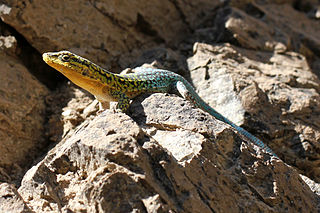
Liolaemus is a genus of iguanian lizards, containing many species, all of which are endemic to South America.

The golden-mantled tree-kangaroo is a critically endangered, furry, bear-like mammal found only in mountain rain forests on the island of New Guinea. Like other tree-kangaroos, it lives in trees and feeds on plant matter. It belongs to the macropod family (Macropodidae) with kangaroos, and carries its young in a pouch like other marsupials. The range is restricted to two small mountain areas in the north and it is threatened by hunting and habitat loss.

The golden-collared honeycreeper is an uncommon species of Neotropical bird in the tanager family Thraupidae. It is the only member of the genus Iridophanes.

Liolaemus nitidus is a species of lizard in the family Iguanidae. It is endemic to Chile, notably within the Chilean matorral ecoregion.
Liolaemus rabinoi, commonly known as Rabino's tree iguana, is a species of lizard in the family Iguanidae or the family Liolaemidae. The species is endemic to Argentina.

Liolaemus tenuis, known as the jewel lizard, is a species of lizard in the family Iguanidae. Other names are thin tree iguana, slender lizard and thin lizard. It is endemic to Chile.

Liolaemus sarmientoi is a species of lizard in the family Liolaemidae. It is considered a medium-sized example of the family, with an average snout–vent length of 76 to 77 mm, with males usually larger than females.
Liolaemus bibronii, Bibron's tree iguana, is a species of lizard in the family Liolaemidae. It is native to Argentina and Chile.
Liolaemus dorbignyi, also known commonly as D'Orbigny's tree iguana, is a species of lizard in the family Liolaemidae. The species is endemic to South America.
Liolaemus duellmani, also known commonly as Duellman's tree iguana, is a species of lizard in the family Liolaemidae. The species is endemic to Argentina.
Liolaemus eleodori, also known commonly as Eleodor's tree iguana, is a species of lizard in the family Liolaemidae. The species is native to Argentina.
Liolaemus etheridgei is a species of lizard in the family Liolaemidae. The species is native to Peru.
Liolaemus foxi, also known commonly as Fox’s lizard and la lagartija de Fox in Chilean Spanish, is a species of lizard in the family Liolaemidae. The species is endemic to Chile.
Liolaemus hermannunezi is a species of lizard in the family Liolaemidae. The species is native to Chile and perhaps Argentina.
Liolaemus irregularis is a species of lizard in the family Iguanidae. It is endemic to Argentina.
Liolaemus josei is a species of lizard in the family Liolaemidae. The species is endemic to Argentina.
Liolaemus puelche is a species of lizard in the family Liolaemidae. The species is endemic to Argentina.
Liolaemus scapularis, the shoulder tree iguana, is a species of lizard in the family Iguanidae. It is from Argentina.
Liolaemus silvanae is a species of lizard in the family Liolaemidae. It is native to Argentina.
Liolaemus vulcanus is a species of lizard in the family Iguanidae or the family Liolaemidae. The species is endemic to Argentina.






